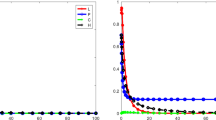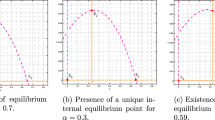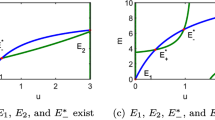Abstract
Ecological theory provides explanations for exclusion or coexistence of competing species. Most theoretical works on competition dynamics that have shaped current perspectives on coexistence assume a simple life cycle. This simplification, however, may omit important realities. We present a simple two-stage structured competition model to investigate the effects of life-history characteristics on coexistence. The achievement and the stability of coexistence depend not only on competition coefficients but also on a set of life-history parameters that reflect the viability of an individual, namely, adult death rate, maturation rate, and birth rate. High individual viability is necessary for a species to persist, but it does not necessarily facilitate coexistence. Intense competition at the juvenile or adult stage may require higher or lower viability, respectively, for stable coexistence to be possible. The stability mechanism can be explained by the refuge effect of the less competitive stage, and the birth performance, which preserves the less competitive stage as a refuge. Coexistence might readily collapse if the life-history characteristics, which together constitute individual viability, change, even though two species have an inherent competitive relation conducive to stable coexistence.


Similar content being viewed by others
References
Abrams PA (1983) The theory of limiting similarity. Annu Rev Ecol Syst 14:359–376
Agnew P, Hide M, Sidobre C, Michalakis Y (2002) A minimalist approach to the effects of density-dependent competition on insect life-history traits. Ecol Entomol 27:396–402
Amarasekare P (2000a) Spatial dynamics in a host-multiparasitoid community. J Anim Ecol 69:201–213
Amarasekare P (2000b) Coexistence of competing parasitoids on a patchily distributed host: local versus spatial mechanisms. Ecology 81:1286–1296
Amarasekare P (2003) Diversity-stability relationships in multitrophic communities: an empirical exploration. J Anim. Ecol 72:713–724
Amarasekare P (2004) Spatial variation and density-dependent dispersal in competitive coexistence. Proc R Soc Biol Sci Ser B 271:1497–1506
Bardsley L, Beebee TJC (1998) Interspecific competition between Bufo larvae under conditions of community transition. Ecology 79:1751–1759
Briggs CJ (1993) Competition among parasitoid species on a stage-structured hast and its effect on host suppression. Am Nat 141:372–397
Finn JA, Gittings T (2003) A review of competition in north temperate dung beetle communities. Ecol Entomol 28:1–13
Gause GF (1934) The struggle for existence. Hafner, New York
Grosberg RK, Levitan DR (1992) For adults only? Supply-side ecology and the history of larval biology. Trends Ecol Evol 7:130–133
Hassell MP, Comins HN (1976) Discrete time models for two-species competition. Theor Popul Biol 9:202–221
Holt RD, Polis GA (1997) A theoretical framework for intraguild predation. Am Nat 149:745–764
Hutchinson GE (1978) An introduction to population ecology. Yale University Press, New Haven
Istock CA (1966) Distribution, coexistence, and competition of whirligig beetles. Evolution 20:211–234
Lack D (1971) Ecological isolation in birds. Blackwell Science, Oxford
Levin S (1974) Dispersion and population interactions. Am Nat 108:207–228
Lotka AJ (1925) Elements of physical biology. Williams and Wilkins, Baltimore
MacArthur RH (1958) Population ecology of some warblers of northeastern coniferous forests. Ecology 39:599–618
MacArthur RH (1972) Geographical ecology. Princeton University Press, New Jersey
MacArthur RH, Levins R (1967) The limiting similarity, convergence and divergence of coexisting species. Am Nat 101:377–385
MacArthur RH, Wilson EO (1967) Island biogeography. Princeton University Press, Princeton
May RM (1972) On relationships among various types of population models. Am Nat 107:46–57
Moe SJ, Stenseth NC, Smith RH (2002) Density dependence in blowfly populations: experimental evaluation of non-parametric time-series modelling. Oikos 98:523–533
Mores CMD, Cortesero AM, Stapel JO, Lewis WJ (1999) Intrinsic and extrinsic competitive interactions between two larval parasitoids of Heliothis virescens. Ecol Entomol 24:402–410
Nakashizuka T (2001) Species coexistence in temperate, mixed deciduous forests. Trends Ecol Evol 16:205–210
Nishimura K, Kishida O (2001) Coupling of two competitive systems via density dependent migration. Ecol Res 16:359–368
Osenberg CW, Mittelbach GG, Wainwright PC (1992) Two-stage life histories in fish the interaction between juvenile competition and adult performance. Ecology 73:255–267
Park T (1962) Beetles, competition and populations. Science 138:1368–1375
Pianka ER (1976) Competition and niche theory. In: May RM (ed) Theoretical ecology. Sinauer, Sunderland, MA
Polis GA, Holt BAM, Winemiller KO (1996) Food webs. Chapman and Hall, New York
Schroder D (1974) A study of the interaction between the internal parasites of Rhyacionia buoliana (Lepidoptra: Olethreutidae). Entomophaga 19:145–171
Tilman D (1982) Resource competition and community structure. Princeton University Press, Princeton
Travis CC, Post WM, DeAngelis DL, Perkowski J (1980) Analysis of compensatory Leslie matrix models for competing species. Theor Popul Biol 18:16–30
Vandermeer JH (1972) Niche theory. Annu Rev Ecol Syst 3:107–132
Walls SC (1990) Interference competition in postmetamorphic salamanders: interspecific differences in aggression by coexisting species. Ecology 71:307–314
Werner EE, Gilliam JF (1984) The ontogenetic niche and species interactions in size-structured populations. Annu Rev Ecol Syst 15:393
Wilbur HM (1980) Complex life cycles. Annu Rev Ecol Syst 11:67–93
Wolfram S (1996) The mathematica book, 3rd edn. Cambridge University Press, Cambridge
Zwolfer H (1971) Proceeding of the advanced study institute on dynamics of numbers in populations. Centre for agricultural Publishing and Documentation, Wageningen, The Netherlands
Acknowledgements
We would like to thank Masakazu Shimada, Yasuhiro Takeuchi, Kazunori Sato, Toshiyuki Namba, Michio Kondoh, and Yoh Iwasa for their comments. We also thank Osamu Kishida for critical reading of the manuscript.
Author information
Authors and Affiliations
Corresponding author
Appendices
Appendix 1
The nontrivial equilibrium values of Eqs. 6a–d are
and
where v=b0γ2/c2.
Appendix 2
Biological feasibility of the equilibrium population densities is satisfied when the fractions C1/B and C2/B in Eqs. 7a and b are positive, given that the persistence condition in Ineq. 9 holds. The necessary condition for the equilibrium to be positive is either of the following:
Case 1:
Case 2:
We verified that if Ineqs. 25a and 25b are satisfied, Ineq. 25c is necessarily satisfied and if Ineqs. 26a and 26b are satisfied, Ineq. 26c is necessarily satisfied. Therefore, the necessary condition for the equilibrium to be positive is reduced to: Ineqs. 25a and 25b in case 1, and Ineqs. 26a and 26b in case 2.
Appendix 3
We chose a set of values of parameters, α, β, α′, β′, v, and φ0, and judged whether the set of parameters is classified into either of the conditions of positive interior equilibrium, i.e., case 1 or 2 in Appendix 2. If the parameters set satisfied case 1 or 2, we designed b0, γ, and c for the given value of v. Then, we get a set of values of parameters, α, β, α′, β′, φ0, b0, γ, and c. For the set of parameters and the equilibrium values (Appendix 1), the dominant eigenvalue associated with the 4×4 Jacobian matrix
which is acquired by the linearized system of Eqs. 6a–d, is evaluated at the equilibrium point. We repeated this procedure systematically for various combinations of the parameters, and inductively confirmed that the equilibrium is stable for the sets of parameters belonging to case 1.
Appendix 4
The partial analysis of the local stability of the equilibrium is constrained, x=(c/γ)X and y=(c/γ)Y, by the direction of perturbations of each species being restricted on each line. With this constraint, we can describe the dynamic equations of both species only by the adult populations, denoted as F X (X,Y) and F Y (X,Y), respectively. The Jacobean matrix of the linearized system of F X and F Y in the state of a nontrivial equilibrium was obtained, and then we found the eigenvalues, −A and C1C2A2/B (these variables are as defined in Eqs. 7a and b). Because we consider that A is positive (thus, −A<0), stability is determined only by the sign of the latter eigenvalue. Therefore, the stability condition is reduced to
Now, since we consider that equilibrium is positive (that is, Eqs. 7a, b are both positive), C1 and C2 have same sign. Therefore, B must be negative for stability, and, consequently, C1 and C2 are both negative. Thus, the stability conditions are again reduced to
Appendix 5
When the interspecific competition is intense at the adult stage and weak at the juvenile stage, the condition of stable coexistence is
Rearrangement of the inequality in terms of b0 leads to the following:
Then, the allowable maximum maturation rate while keeping a positive interval of b0 in Ineq. 28b is obtained by solving the equality,
Considering γ>0, the allowable maximum maturation rate is
About this article
Cite this article
Mougi, A., Nishimura, K. Coexistence of competitive species with a stage-structured life cycle. Ecol Res 20, 581–589 (2005). https://doi.org/10.1007/s11284-005-0070-9
Received:
Accepted:
Published:
Issue Date:
DOI: https://doi.org/10.1007/s11284-005-0070-9




